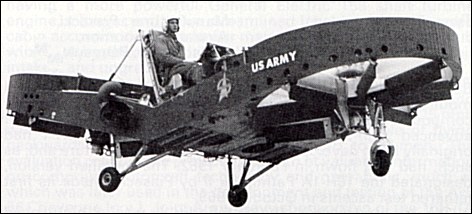
| Piasecki 59H / VZ-8P (B) "Airgeep II" 1952 |  |
 |

| Piasecki 59H / VZ-8P (B) "Airgeep II" 1952 |  |
 |
|
The second VZ-8P incorporated several significant design changes and was, accordingly, dubbed the Model 59H "Airgeep II" by Piasecki and the VZ-8P (B) by the Army. This vehicle's most obvious differences from its predecessor were an angled rear duct, the installation of two 300kW Artouste IIC engines, zero-altitude zero-speed ejection seats for the pilot and added co-pilot/gunner, seating for up to three passengers, and the addition of powered tricycle landing gear meant to improve ground handling and provide a measure of overland mobility. The "Airgeep II" made its first non-tethered flight in the summer of 1962. Neither version of the VZ-8P was dependent upon surface- effect lift for flight and, though intended to operate within a few feet of the ground in order to make the best use of natural cover, both were quite capable of flying at altitudes of several thousand feet. Both versions were found to be quite stable and relatively capable craft, able to hover or fly beneath trees and between buildings or other obstacles. In addition, the Airgeep was found to be a surprisingly effective weapons platform, able to engage targets with only the weapon and its sight visible above the line of defilade. This remains a unique talent, for even modern battlefield helicopters must rise above the line of defilade to fire their weapons (which are mounted below the rotor plane) thus revealing themselves and providing a much greater target area.
Despite its many positive qualities the Airgeep, like most "flying jeeps" developed during this period, was ultimately judged by the Army to be mechanically ill-suited to the rigors of field operations. The "flying jeep" concept was eventually abandoned in favor of the further development of conventional battlefield helicopters, and both VZ-8P examples were dropped from the Army's inventory in the mid-1960s.
|